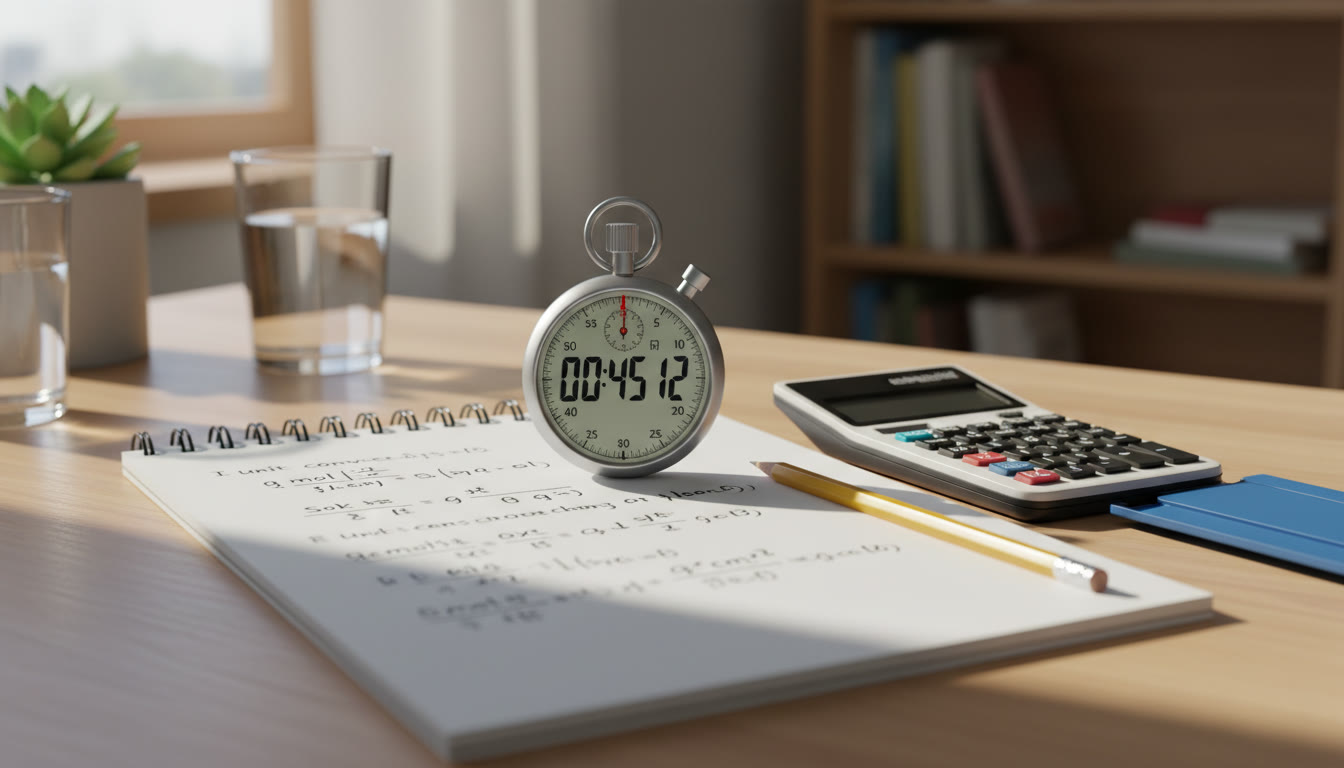Why Units and Dimensional Checks Matter — Especially When the Clock Is Ticking
When the proctor calls time and you’re still staring at a problem, it’s easy to blame nerves. But many last-minute mistakes aren’t about nerves alone — they’re about units. Knowing how to handle units and perform quick dimensional checks will save you time, reduce anxiety, and bump up your score in those crucial AP sections where partial credit or a correct set-up matters.

Units are the guardrails of reasoning. They tell you whether an algebraic manipulation even makes sense. Dimensional checks are simple sanity tests: do the units on the left-hand side of your equation match those on the right? If not, there’s a mistake waiting to be found. That check is fast — often only a few seconds — and can rescue a response that otherwise looks algebraically plausible but is physically impossible.
How This Guide Helps You
This blog is written for AP students (Physics, Chemistry, and other quantitative APs) who want to make unit-savvy thinking automatic. You’ll get:
- Practical rules for quick checks under time pressure.
- Worked examples you can replicate in the test room.
- Time-saving shortcuts and when not to use them.
- A compact reference table you can memorize in minutes.
- Study-plan suggestions, including how Sparkl’s personalized tutoring can fit naturally into focused prep.
The Core Idea: Units Are Algebraic Objects
Think of units (seconds, meters, kilograms) as algebraic variables that follow multiplication, division, and exponent rules. You can cancel meters with meters, multiply meters by seconds, or raise seconds to a power. When you treat units algebraically, dimensional consistency becomes a simple bookkeeping exercise: ensure both sides of an equation have the same unit “type.” If not, you’ve revealed an error — sometimes big, sometimes tiny.
Quick Rules — Dimensional Analysis Cheat-Sheet
- If an expression equals an acceleration, expect units of length/time^2 (e.g., m/s^2).
- Energy has units of force × distance (e.g., N·m = joule), or mass × length^2 / time^2 (kg·m^2/s^2).
- Frequency is 1/time (Hz = s^-1).
- Convert once at the start when possible. Keep a consistent base: SI units (m, kg, s) reduce errors.
- Watch derived units: newtons, pascals, joules — translate them to base units when confused.
Example Walkthroughs — Practice That Feels Like the Real Exam
Below are step-by-step examples you can use as templates. Each emphasizes a quick dimensional check early in the solution.
Example 1 — Kinematics (Physics AP)
Problem idea: A ball moves with constant acceleration. You’re given distance in meters and time in seconds and asked for acceleration.
Fast plan:
- Write the kinematic equation that fits the given quantities, e.g., x = x0 + v0*t + (1/2) a t^2.
- Rearrange to solve for a: a = 2(x – x0 – v0*t)/t^2.
- Dimensional check: numerator has units of meters, denominator t^2 gives s^2, so a has units m/s^2 — correct.
- Plug in numbers. If units aren’t m and s (say x is given in centimeters), convert first or convert result at the end — but convert consistently.
Example 2 — Newton’s Second Law with Derived Units
Problem idea: Given force in newtons and mass in grams, find acceleration.
Fast plan:
- Remember Newton: F = ma, so a = F/m.
- Dimensional thinking: 1 N = 1 kg·m/s^2. If mass is in grams, convert to kg by dividing by 1000.
- Check units: (kg·m/s^2) / kg = m/s^2 — good.
- If you forget to convert, you’ll be off by a factor of 1000. Under time pressure, a one-line unit check would have caught it.
Example 3 — Chemistry Concentration and Rates (Chemistry AP)
Problem idea: Reaction rate given in mol·L^-1·s^-1, concentration change in mol/L. Calculate reaction time.
Fast plan:
- Isolate time by rearranging the rate expression: time = concentration change / rate.
- Dimensional check: (mol/L) / (mol/L/s) = s — correct.
- If you’re given moles per m^3 instead of L, convert to avoid factor-of-1000 errors.
Time-Saving Habits You Can Learn in a Week
Under exam pressure, a few habits are worth drilling until they’re reflexive. Spend a little practice time now — it pays off quickly.
Habit 1 — Pick a Base Unit System and Stick With It
Choose SI (meter, kilogram, second) for most physics and chemistry problems. If an AP problem uses cgs or weird units, convert once rather than converting repeatedly inside your algebra. Converting once at the top reduces arithmetic mistakes.
Habit 2 — Annotate Units While You Work
Write units next to expressions as you manipulate them. This costs a few extra seconds but saves minutes later when you have to figure out why two terms can’t add. Be precise: v and v^2 are different beasts — v has m/s, v^2 has m^2/s^2.
Habit 3 — Use Dimensional Checks to Pick Right Equations Fast
If a problem offers multiple formulas, do a quick units match before selecting one. Often you can eliminate wrong choices solely by checking units, which saves time you might otherwise spend rearranging algebraically.
Common Unit Pitfalls and How to Avoid Them
These are mistakes students repeat under stress. Recognize them now so they stop happening on test day.
- Forgetting conversions like grams to kilograms or centimeters to meters.
- Adding quantities with different units (e.g., mixing m and km without converting).
- Dropping squared or cubed units (e.g., writing m instead of m^2).
- Misreading rates: speed (m/s) vs. acceleration (m/s^2) vs. jerk (m/s^3).
- Misinterpreting derived units: pressure is force/area (Pa = N/m^2) — expand to base units when in doubt.
Fast Fixes
- When in doubt, expand derived units to base SI units before algebra.
- Circle all units given in the problem before doing calculations.
- If you’re rushed, do a final unit check immediately after your last arithmetic step — often you’ll catch a misplaced factor or missing conversion.
Short Table: Unit Targets and Quick Identifiers
This table gives a compact reference you can memorize quickly. It helps you identify what unit to expect for a quantity and how to check it fast.
| Quantity | Common Symbol | Expected Units | Quick Check |
|---|---|---|---|
| Distance / Displacement | x, s, d | m, cm, km (convert to m) | Should be L (length) |
| Speed / Velocity | v | m/s, km/h (convert to m/s) | Length / Time |
| Acceleration | a | m/s^2 | Length / Time^2 |
| Force | F | N (kg·m/s^2) | Mass × Acceleration |
| Energy | E | J (kg·m^2/s^2) | Force × Distance |
| Power | P | W (J/s) | Energy / Time |
| Pressure | P | Pa (N/m^2 = kg/m·s^2) | Force / Area |
Under Time Pressure: The 3-Point Dimensional Speed-Check
When you have less than a minute, use this micro-routine. It’s built to be fast and reliable.
- Identify the target quantity and write its expected units (5–8 seconds).
- Quickly expand any derived units given in the problem into base units if you’re unsure (8–12 seconds).
- After algebra, compare units on both sides. If they don’t match, scan steps where you canceled or converted (10–20 seconds).
This routine takes about 25–40 seconds when practiced — a small investment for a high return in accuracy.
When Not to Use Shortcuts
Shortcuts are powerful, but don’t substitute for understanding when the algebra is tricky — for example, when vector directions matter or when you have implicit unit factors (like gravitational constant G with unusual units). In those cases, slow down, expand units fully, and consult the fundamental definitions.
Memorization vs. Intuition — What to Learn and What to Derive
On AP exams, memorize a short list of base relationships, but rely on dimensional derivation for complex or unfamiliar expressions.
- Memorize: basic definitions (1 N = 1 kg·m/s^2, 1 J = 1 N·m), common conversions (g ↔ kg, cm ↔ m, L ↔ m^3), and the meaning of frequency/period pairs.
- Derive on the fly: unfamiliar composite units — expand them into base SI units and cancel algebraically.
Practice Drills You Can Do in 20 Minutes
Make dimensional checks a habit with quick daily drills. Repetition builds recognition — you’ll start catching unit mismatches without thinking about them.
Drill 1 — Unit Matching Flashcards
Create flashcards: one side has a quantity name or formula, the other side has expected units. Drill until you can answer in under five seconds.
Drill 2 — Rearrangement Race
Write three typical AP problems, set a 5–7 minute timer, and solve them with explicit unit annotations. Speed is the goal, but don’t sacrifice correctness.
Drill 3 — Mistake Hunt
Get a set of worked solutions (teacher’s key or practice AP problems) and identify where units are mishandled. Turn mistakes into micro-lessons: what conversion was missed? Which algebra step changed the unit unexpectedly?
How Personalized Tutoring Can Accelerate Mastery
When you’re racing the clock, targeted feedback shortens the path from slow to automatic. That’s where tailored help can make a big difference. For example, Sparkl’s personalized tutoring gives focused 1-on-1 guidance, helps you build a tailored study plan, and offers expert tutors who can pinpoint recurring unit mistakes. Add AI-driven insights and you get recommended drills based on your patterns — so your practice hits weak spots, not random problems.
What to Expect from a Focused Tutoring Session
- Immediate feedback on common unit errors and targeted strategies to fix them.
- Practice problems designed to convert slow habits into quick checks.
- Personalized pacing — you’ll spend more time on what you struggle with and less on what you already know.
Final Exam-Day Checklist for Units
Print this checklist, memorize it, or write it on your scrap sheet during the AP exam if allowed. It’s compact and built for exam-day stress.
- Circle given units and expected final units before starting your algebra.
- Convert all measurements to a single consistent system (preferably SI) early.
- Annotate units during algebraic manipulation — one-word reminders: cancel, square, cube.
- Use the 3-point dimensional speed-check after completing each solution.
- When time is nearly up, perform at least one final unit sanity check on your most important answers.
Sample Mini-Test (Do This in 10–15 Minutes)
Try this mini-set to measure your readiness. Don’t use a calculator on the first pass — focus on units and setup. Then compute answers and check units.
- 1) A car travels 100 km in 2 hours. Find average speed in m/s. Show unit steps.
- 2) A force of 20 N acts on a 5 kg mass. Find acceleration. Write units at each step.
- 3) The intensity of light is given in W/m^2. If a lamp puts out 60 W and the beam covers 2 m^2, what’s the intensity? Show unit cancellation.
Score your work: if you made a unit mistake, identify whether it was a conversion, cancellation, or misreading. Convert each error into a 5‑minute drill for the next day.
Wrapping Up — Make Units Your Safety Net
Units aren’t just pedantic details: they’re your fastest check against unreasonable answers. With a handful of habits — pick a base system, annotate units, and run quick dimensional checks — you’ll catch many errors that otherwise cost points. Practice these habits in short daily drills and use targeted tutoring where you stall; for example, Sparkl’s 1-on-1 sessions and tailored study plans can help you internalize checks so they happen automatically on test day.
One Last Tip
When you’re tempted to trust a calculator or a memorized formula, ask one simple question: “Do the units make sense?” If the answer is anything but a confident “yes,” pause, expand the units, and fix the setup. That three-second question will rescue more answers than you expect.

Good luck. Build your unit sense now, and it will be a calm, reliable companion when exam pressure peaks.
















No Comments
Leave a comment Cancel